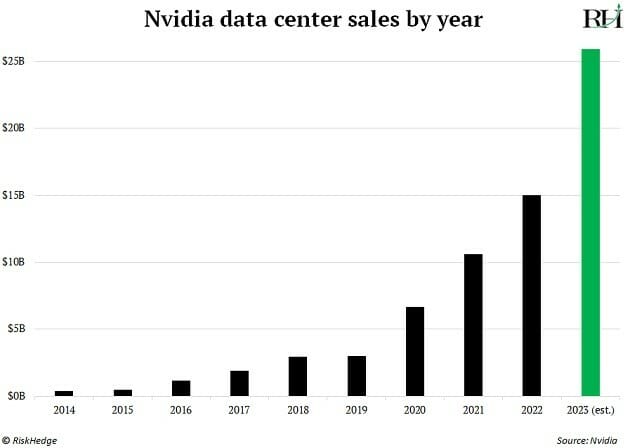When the greatest trader of our generation makes a prediction, I listen.
Steve Cohen amassed a $17.5 billion fortune by creating one of the most successful hedge funds of all time.
He had enough spare cash lying around to buy The New York Mets!
And Cohen said something interesting at a private conference in New York recently: “I’m making a prognostication—we’re going up.”
He warned investors not to miss the “big wave” of opportunities brought on by artificial intelligence (AI).
How To Invest In Ai
- Today, I’ll show you how to invest in AI…
By now, you likely know all about ChatGPT.
The chatbot attracted 100 million users within two months of launching. It’s also ignited a stock market frenzy.
AI chip leader Nvidia (NASDAQ:NVDA) has tripled since January. I first told readers to buy this stock five years ago.
Palantir (NYSE:PLTR), which uses AI to catch “bad guys,” surged 150%.
ChatGPT runs on Microsoft’s (NASDAQ:MSFT) cloud servers. That connection added $900 billion to Microsoft’s market cap this year.
Today, I’ll walk you through my three rules for investing in AI. These crucial insights will help you profit from one of this decade’s most disruptive forces.
Rule #1: Avoid AI ETFs
These days, there’s an ETF for everything. Want to invest in space? Buy the Space ETF (NYSEARCA:UFO). Want to buy some “sin” stocks? The Vice ETF (NYSEARCA:VICE) has you covered.
There’s also a raft of AI ETFs. But I wouldn’t touch these with a barge pole.
Buying these ETFs is like buying “fake” luxury goods. The logo might say Louis Vuitton, but it’s not the real deal.
These funds are packed full of companies saying they’re working on AI. But the reality is AI only makes up a tiny sliver of their overall businesses.
It’s all AI-related or AI-adjacent. When you drill into their numbers to see how much money they’re making from AI, it’s minuscule.
Filter out the fakes. Avoid AI ETFs.
Rule #2: Nvidia Isn’t The Only Ai Stock You Should Own
Nvidia has surged almost 600% since I first wrote about it back in 2018.
You may know Nvidia is singlehandedly powering the AI boom. With a 95% market share, the world’s best supercomputers all run on its GPU chips.
And it’s making mountains of cash from AI today. AI-related data center sales hit $4.3 billion last quarter. And Nvidia expects AI revenues to surge to $8.5 billion in the current quarter.
For perspective, it raked in $7.2 billion total in the first three months of the year.
In other words, Nvidia’s AI arm will soon be larger than its whole business!

When you look at the amount of cash companies generate from AI, Nvidia is in a league of its own.
But it’s not the only AI stock you should buy. Investors are overlooking the “hidden” boom.
Everyone is fixated on ChatGPT today. But they’re missing the fact that many companies are using different types of AI to disrupt massive industries.
I’ll give you one example: Health Catalyst (NASDAQ:HCAT). It’s a little-known company trying to solve healthcare’s “paperwork problem.”
A recent study found for every hour doctors see patients, they spend nearly two hours on paperwork.
The ever-increasing administrative burden is a huge contributor to rising healthcare costs. Since 1970, the number of healthcare administrators has surged 35X faster than the number of doctors.
Health Catalyst’s platform collects and makes sense of trillions of pieces of healthcare data from hundreds of sources.
Texas Children’s Hospital used its tech to reduce wait times for new patients… add 53,000 appointments annually… and boost annual revenue by $8.3 million.
The entire AI boom runs on Nvidia’s graphics chips. It’s a must-own stock. You should also look for “hidden” AI winners—little-known firms using AI to disrupt huge industries.
Rule #3: Embrace The AI Bubble Until…
Wall Street powerhouse JPMorgan recently asked its clients: “Are AI stocks in a bubble?”
Almost two-thirds of them answered, “Yes.”
Investors poured 3X more money into AI start-ups last month than they did in all of 2022. And get this… a four-week-old AI company in Europe just raised $100 million. It hasn’t even built a product!
If it walks like a bubble and talks like a bubble, it’s probably… a bubble.
But that doesn’t mean you should avoid AI stocks.
I was recently talking with a friend who runs a hedge fund in London. We were discussing AI, and he said, “I love investing in bubbles. It’s how you make big money, fast. You’ve just gotta know when to sell.”
All bubbles have one thing in common: They shower investors with stock market profits on the way up.
AI might be in a bubble, and that means you must own these stocks. As my friend said, “You’ve just gotta know when to sell.”
The “IPO curse” is a signal that will tell me when to run for the exits. I’m waiting for a high-profile AI firm to go public.
I’m struck by how many times the leading company in a hot sector has gone public and marked “the top”…
- The AOL Time Warner merger in 2000—still the largest ever—culminated in the dot-com bust.
- The Blackstone (NYSE:BX) IPO in 2007 coincided with the top for financial markets and preceded the Great Recession.
- Glencore’s (OTCMKTS:GLNCY) 2011 listing marked the peak in the commodity super-cycle.
- Coinbase’s (NASDAQ:COIN) IPO looks like it marked a top for crypto, at the very least.
We’re at least a year away from a high-profile AI IPO. This tells me the AI trend has a long way to go before it matures—and that stocks like Nvidia can keep climbing.
There’s one more top signal on my watch list: Nvidia becoming the world’s largest company.
It’s currently in sixth place, trailing Apple (NASDAQ:AAPL) by $1.9 trillion.
Nvidia claiming the crown as the world’s largest company seems unlikely, but anything is possible as the AI boom heats up.
Article by Stephen McBride – Chief Analyst, RiskHedge
To get more ideas like this sent straight to your inbox every Wednesday and Saturday, make sure to sign up for The RiskHedge Report, a free investment letter focused on profiting from disruption.
Expect smart insights and analysis on the latest breakthrough technologies, the big stories the mainstream media isn’t reporting on, and much more… including actionable recommendations.





